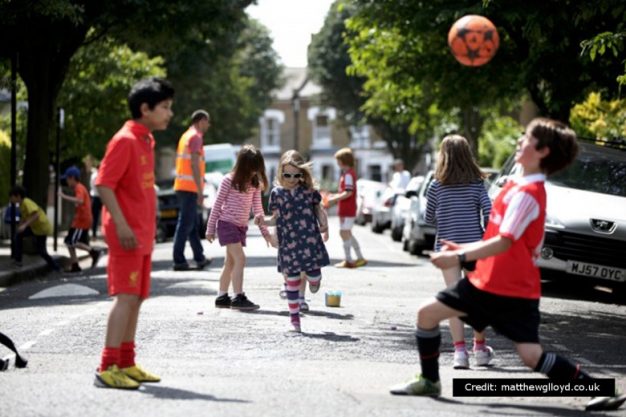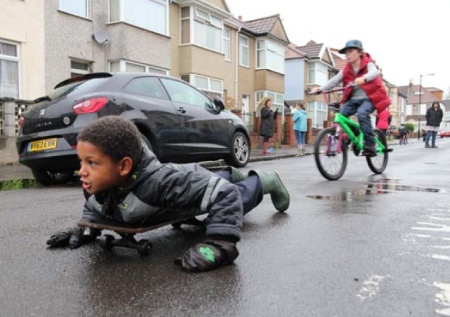
Could street play hold the key to sustainable cities?
This week saw a milestone in the UK street play movement, with the publication of three new reports. Here, Tim Gill, the author of one of them, reflects on the research, and its significance for the wider child friendly city movement
Three reports were published this week on the street play phenomenon that has been steadily growing across the UK over the few years. The first is an evaluation report by the University of Bristol, published by Play England, which looks mainly at the health outcomes for children. The second is a report from Playing Out CiC, the Bristol-based national hub for street play, of a survey of people directly involved in street play sessions. The third, written by me and also published by Play England, explores the issues around taking street play initiatives forward in disadvantaged areas.

All three reports focus on the model of regular, resident-led, temporary road closures in residential streets. Taken together, they show that street play can have a profound and lasting impact on both children and the wider community. The model is also low-cost, sustainable and widely applicable (though there are challenges in hihgly disadvantaged areas and/or housing estates with non-traditional road layouts).
“Policymaker’s dream come true”
Hence it is hard to argue with the statement from Playing Out that the model is “any policymaker’s dream come true” and that there is an urgent need for both national and local government to “provide the policy and practical support needed to make it easy for residents anywhere to initiate and sustain it.”
It is telling that one of the areas where the model has been most successful – the London Borough of Hackney, where the current total is round about 50 streets – is also an area that has become dramatically less car-dominated in recent years. Statistics from the 2001 and 2011 censuses show:
- The proportion of trips made by car halved
- The number of walking commuters doubled
- The proportion of people with access to a car fell by over 20%
- More residents cycle to work than any London borough, while more residents cycle (15.4%) than drive (12.8%).

Hackney travel mode changes 2001-11
In truth, these changes are happening all over London, though at a slower rate than in Hackney. Across my home city – and in many other cities around the world, including Calgary, Lyon and Melbourne – cars are vanishing from neighbourhoods. This poses the question: what might residential streets become, once they are no longer the sole preserve of the car? What Hackney shows is that many could become places for play and community life.
Dominance of the car
There is little doubt that the dominance of the car is the biggest barrier to making cities more sustainable and livable. But equally, many urban residents need access to cars, and are hostile to changes that may make their lives more difficult. Tackling car dependence is perhaps the definitive wicked issue for urban policy makers.
This is where play streets come in. They show ordinary people how their lives would be improved if their neighbourhoods were less car-dominated, building support for policies that make cities more sustainable and liveable for everyone. They help people join the dots between big, complex topics like pollution, transport planning and community cohesion on the one hand, and everyday life in residential streets on the other. And they help to create virtuous circles that build sustainable lifestyles and attitudes across the generations and over the decades to come.
I feel inspired that things that can be done to help, not just kids to play outside, but everyone to experience the city without fear of traffic
– Playing Out survey respondent
This is not just speculation: revealing personal accounts from street play advocates show the process in action. To take a few quotes from the Playing Out survey: “I feel more empowered to make positive change in my community and feel l can positively impact the street where I live. I feel a greater sense of ownership of my street. I feel more confident at giving my daughter independence,” or “I feel inspired that there are things that can be done to help not just kids play outside but everyone to experience the city without fear of traffic.”
No silver bullet
Let’s be clear: play streets are not a silver bullet for making cities more child-friendly. Much more is needed: more investment in walking, cycling and public transport, smarter ways to tame traffic in residential streets, more attractive, better-managed parks and green spaces (and better access to them), and better-designed housing estates and new towns. (My Churchill Fellowship research will explore how different cities have pursued these goals).
That said, I still believe that resident-led street play is the most promising child-friendly idea to have emerged in the last 20 years. The reports published on Monday prove the difference play streets make to children, families and communities. They also show the power of a vision of less car-dominated, more child-friendly neighbourhoods.
Tim Gill
Main photo: Playing Out
Inset photo and graphic: Rethinking Childhood
A summary of the Playing Out research reports, along with an overview of the UK media coverage of their publication can be read here,
First published on Rethinking childhood




Why temporary road closures? Is area calming and filtered permeability heretical?
Thanks for your comment Clive. To the car lobby it may well be. The Playing Out movement is a grass roots response, parent-led, wherein local people are utilising existing laws to do what they can to make their streets safer and more playable for their children. Currently that means temporary street closures, but the movement is in its relative infancy, growing in profile, reach and and influence all the time. Personally, I hope that it will stimulate the liveability debate towards the need for longer-term solutions.